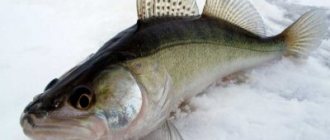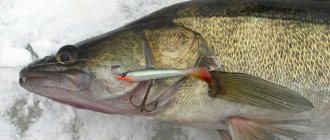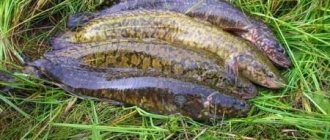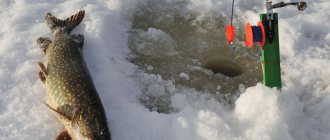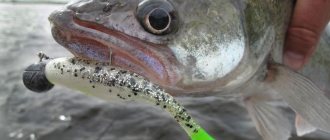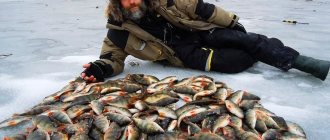Pike perch is one of the most common freshwater predators in our reservoirs. He can be called the most productive and successful, and he hunts all year round. This means that you can catch pike perch in any season, you just need to vary your gear and fishing tactics. At different times of the year, he differentiates his own preferences, and this must be taken into account when organizing a fishing session.
Today we will get acquainted with the usual habitats of the fanged pike perch (as the pike perch is called for the special structure of its mouth, decorated with impressive teeth), and cover its basic food preferences and habits. And, most importantly, let’s listen to experienced fishermen who have specialized in catching this predator for more than one season. Their practical experience is truly priceless!
Where does pike perch live?
Pike perch and its closest relative, the bersh, live almost throughout the entire territory of Russia, with the exception of the coldest regions. Most of all, he loves deep rivers and lakes with running clean water, as he is very sensitive to the amount of oxygen. In this regard, fishing for pike perch in overgrown bays, stagnant reservoirs and ponds is futile. However, this predator does not disdain entering river mouths, where there is a fairly significant addition of salt water, as well as into backwaters with a reverse flow.
This bait provides a rich catch even with a bad bite! More details Adult pike perch spends the lion's share of time at a considerable depth near the bottom, and gives preference to hard surfaces. A silted or overgrown bottom with algae does not appeal to him. Only young owners of growing fangs can permanently live in shallow water and coastal thickets.
The fanged fish extremely rarely leaves its usual habitats, the only exception being the spawning period. During this period, in the spring, mature pike perch set up nests in coastal thickets, in snags in relatively shallow water areas and in other secluded places.
At other times, you should look for pike perch in open water :
- in creeks with a barely noticeable reverse current;
- in holes at considerable depth (hunts on slopes);
- on a snagged and littered bottom;
- in places of bottom anomalies;
- near hydraulic structures (dams, dams, embankments, bridges);
- along edges and slopes;
- in the pools beyond the river rapids.
Pike perch is productively caught close to its usual habitats - it moves away from its favorite holes and snags only a short distance, and exclusively for the sake of hunting.
Character and lifestyle
The fish have a solitary lifestyle (unlike perches). Pike perch are active around the clock. At night it is more and can go to the shallows. During the daytime it prefers a depth of 3–5 meters. Shelter is found at the bottom of sand or pebbles, where there are more snags and stones.
Pike perch is a high-quality, fast swimmer. Its speed can reach one meter per second for hours. At the same time, the fish does not lose the ability to make throws. In case of danger, the speed increases to two meters per second, but can last up to 30 seconds.
Underwater hunters do not frighten the predator; pike perch can approach a person at a very short distance. If a pike perch gets caught in a fishing net, it shows no resistance and falls asleep in a short time.
Food preferences and hunting methods
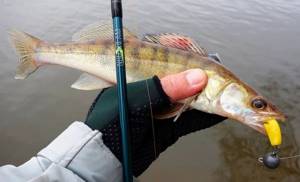
Young pike perch that have not reached maturity prefer to stay in schools in shallow water, gradually moving to depth as they grow older. Large fish of commercial interest live and hunt mainly alone or in small groups of several individuals, gathering in schools only before leaving for wintering and spawning. You rarely see a two-kilogram individual in the company of its own kind, especially in the summer.
Pike perch hunts using both driven and ambush methods. It usually ambushes potential prey, but pursues it until it is caught or realizes the futility of further pursuit. The so-called “battle” looks especially impressive, which can be observed at dusk and in the pre-dawn darkness. The pike perch accelerates like a torpedo, reaching the very surface of the water, and actively pursues prey, making loud splashes and practically jumping out of its native element. It is for this reason that in summer it is best to catch pike perch at night, during the period of maximum activity.
The basis of the fanged fish's food base is juvenile fish, and it prefers prey with a narrow, slender body. It consumes huge quantities of bleak, spined lance, dace, gudgeon, young perch, roach, rudd, and so on. Sometimes he does not disdain his own relatives, especially with a limited food supply. On occasion, its prey will include a frog, leech, lamprey, crayfish, a particularly tasty worm or a large dragonfly.
Where to look for pike perch on the river?
Since most fishing for pike perch takes place on rivers, it would not be amiss to dwell in more detail on where and when to catch it. So, this predator is a twilight fish. His eyes have a structure that helps him capture even faint reflections of light. This, of course, helps him hunt in semi-darkness. But during the day this advantage turns into a disadvantage. Pike perch hides from bright rays in the depths of the water. It can stay in the shade of snags and fallen trees, hide under large stones and in bottom holes.
And if we take into account that this predator prefers to stay in the current near a hard bottom, then first of all it is looked for on rivers near channel edges and under snags. In such conditions, the pike perch, in order not to waste energy on a useless struggle with rushing waters, simply digs a small hole in the ground for itself and waits there for sunset.
So, we have mentioned the main places where to catch pike perch in the daytime. But such fishing will not bring large catches; mostly small individuals will be caught. But during dawn it is better to look for predators near spillways and sluices. The pike perch stands here, hiding behind the stones and waiting for small fish, stunned by the whirlpool. Fishing will also be successful near bridge supports and reinforced concrete structures that have collapsed into the water. It wouldn’t be a bad idea to fish the areas where the border between direct and reverse currents passes - the pike perch will probably be standing here too. At dusk, the “striped” predator goes hunting in the shallows, especially where there is aquatic vegetation. When the sun sets, splashes are heard here - these are pike perch chasing fry. Naturally, at different times of the year the predator behaves differently. Therefore, there are many options for fishing for this type of fish: from a float rod to a donkey and a spinning rod.
Features of fishing by season
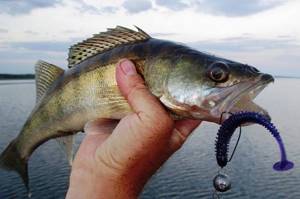
Pike perch is active all year round, only the intensity of food consumption changes. Let's look at this issue in more detail.
In the spring, pike perch prepares for spawning and fattens up. At this time, as fishermen say, he “grasses” herds of peaceful fish, accompanying them to spawning areas and at the same time hunting for weakened and strayed individuals. At this time, spinning fishing is the most productive: pike perch actively pursues wobblers and silicone baits. Bottom gear in the spring is not particularly catchy. It should be remembered that during the period of spawning restrictions, the use of spinning rods and donkeys with several leashes is not permitted in all reservoirs.
During the spawning period, which occurs in the middle zone around May, pike perch of commercial size stops actively hunting: it is preoccupied with procreation. By the way, females leave the spawning grounds earlier, and males continue to guard the clutches for several weeks. During this period, catching pike perch is not only unpromising, but also prohibited at the legislative level.
The bite resumes in early summer , during the post-spawning feeding period. Pike perch switches to the main diet, consisting mainly of perch, dace and juveniles of other fish. In summer, the food supply is plentiful, and pike perch can afford to be picky in terms of food. In the summer, night fishing from a boat is especially promising, and you can use both float gear and a fishing rod, as well as a spinning rod. Bottom gear equipped with a worm, frog, and live bait (small or cut fish) also performs well. They are thrown at night along the shallows, where the predator comes out in search of prey.
During the hot day, pike perch is practically not caught - it moves to great depths, inaccessible to the fisherman. The exception is periods of cold weather after persistent heat, as well as pre-storm hours, when the bite can reach the level of zhora.
In the fall, pike perch again begins to actively gain fat, and the bite shifts to daytime hours. It goes to even greater depths in search of larger prey: crucian carp, bream, roach. You need to look for it at the boundaries of the depth difference, which is difficult without a preliminary study of the bottom topography. But small pike perch go well with bottom tackle or spinning rods from the shore, and are not particularly picky about bait.
With the onset of cold weather, pike perch shifts towards wintering pits, where representatives of carp breeds go. Usually it accompanies the bream with honor, feeding on its young throughout the winter. The exception is the deaf winter, when due to lack of oxygen the fanged one becomes lethargic and inactive. But on first ice, during periods of thaws and stable sunny weather, pike perch are successfully caught using balance beams and vertical spoons. Sometimes the fanged one is also caught on girders intended primarily for pike.
With the onset of spring, even before the opening of reservoirs, the predator becomes active again and begins to feed. It leaves its wintering grounds together with the bream, successfully hunting and preparing for spawning.
Effective tackle and bait

Each season involves the use of a certain type of gear in tandem with bait. That is, it is possible to fish with other gear, but hunting for fanged fish will be ineffective. At the moment, pike perch in open water is caught on:
- Spinning . The most versatile and catchy tackle for open water, deservedly loved by fans of active fishing. All types of spinners, wobblers, as well as soft baits with jig heads or in combination with spaced equipment are used as bait.
- Summer girders . In most cases, classic baitfish are not very productive: they provide for a limited distance from the shore. But you can and should catch pike perch on floating mugs.
- Bottom gear . Large pike perch lead a bottom-dwelling lifestyle, which makes the use of bottom gear justified. However, his love for a snagged bottom sometimes makes the use of donks impossible.
- Float equipment . Another traditional option for catching pike perch is a powerful telescopic fishing rod with float equipment. It is highly advisable to use a boat.
- Plumb fishing . A very effective way to catch fanged fish from the side of a watercraft. In this case, either a fishing rod or a short spinning rod is used. This option allows you to fish the deepest holes and attract pike perch at all water levels.
Now let’s take a closer look at the nuances of pike perch fishing.
Spinning fishing
Spinning is a tackle for active fishing of all predators. With its help you can also catch pike perch, although the fanged one is considered a much more “complex” predator than perch or even pike.
The most catchy time for a spinning angler is spring (remember the spawning ban!) and early autumn (until mid-October). At this time, the water is saturated with oxygen, and decent pike perch can be caught even from the shore, at relatively shallow depths. In the summer, you have to fish “difficult” deep areas, relying on echo sounder readings and visual signs of depth changes. It’s a good idea to try fishing where streams and small rivers flow into the main channel or flowing lake.
Of all the spinning fishing methods, jig performs best: it is most effective in spring and autumn. Posting – classic or long step: pike perch loves expressive and orderly play of the bait, without unnecessary chaos.
The following are used as bait:
- long-sized soft twisters and vibrotails;
- silicone frogs;
- flies with pronounced front loading;
- foam fish.
For active fish, spinners use silicone baits as part of traditional equipment (jig head with hook and bait). However, when the pike perch is not too active (especially in the summer), a diverting leash (Moscow rig) works best.
As an alternative, we can recommend oscillating spoons - they are suitable for catching pike perch at a depth of 4-5 meters. At short distances and depths, “spinners” are also quite good with classic uniform wiring. The use of wobblers with zigzag wiring such as twitching (with expressive yaw from side to side) is justified with sufficient skill of the fisherman and the correct selection of the bait, not only in design and size, but also in the degree of depth.
Summer girders
Summer bait is one of the most common live bait gear. A classic of the genre are rigs , consisting of a fishing line with equipment on a reel and attached to a support on the shore. Unfortunately, due to the behavioral and physical characteristics of pike perch, this option is ineffective. However, sometimes equipment installed in the right place, near the fanged site, brings the desired result.
Mugs , which are a floating type of girders, perform much better Floating disks with “masts” and fixed equipment are equipped with live bait and set sail. In this case, it is especially important to select a promising pike-perch place and set the correct depth so that the bait is located directly at the bottom, but does not cling to it. A couple of circles from the entire tank can be placed at a depth of half water, in the expectation that the predator has gone hunting closer to the surface.
Circle fishermen usually start catching pike perch just before dawn, because it fattens up to a maximum of 7-8 hours. Night hunting is also promising, but there is a problem with visibility of the bite in the dark. We remind you that a boat is required to launch and maintain the circles.
Bottom gear
The donka rod is a fairly popular pike-perch tackle that allows you to fish large areas at long distances and great depths. There are no special requirements for choosing a fishing rod; the equipment is also simple and not pretentious. There are many options for equipment, but the most popular is installation with a side leash 15-20 cm long (a load weighing up to 50 grams is attached to it). The length of the main leash is 50-70 cm, the hook is a live bait double or tee (other options are possible when using other baits). There is no particular need for a reinforced leash (steel, Kevlar), but it is better to use it, since no one guarantees that a sharp-toothed pike will not be tempted by the bait.
The advantages of this gear include the possibility of simultaneous feeding. It is carried out through the feeds familiar to adherents of bottom gear: springs, methods, nipples, and so on. The feeder is hung on a side leash in front of the sinker, and if there is no current, it replaces it. In this case, the basis of the feed mixture is made up of plant ingredients, but animal components are also mixed into them immediately before casting. It is good to use offal, dried blood, chopped worms or bloodworms.
The main disadvantage in this case is the high probability of damage to live bait when casting. You can use a frog, a leech or a bunch of worms, but it is problematic to attract finicky large pike perch in this way. Therefore, it is worth resorting to an alternative method of attaching live bait without mechanical damage: we do not pierce the body of a small fish with a hook, but secure it with a rubber band. However, if such subtleties do not appeal to you, you don’t have to bother and equip the donka with sliced fish.
Pike perch can also be successfully caught using a classic rodless donka with several leashes, as well as its modified version - an elastic band. In this case, the fickle nature of the fanged one is taken into account: it is not known when it will go hunting, but such gear can be set up for the whole night. Several leashes with live bait increase the likelihood of a bite. Among the disadvantages, it is worth mentioning the limited use of these gears: the fishing place must not only be potentially attractive to a predator, but also free from bottom debris and thickets. A clean water area with a pronounced difference in depth is an ideal option. You can also install donks along the boundaries of the shallows, where the fanged one comes at night in search of prey.
Plumb fishing
Plumb fishing is carried out either from the side of a boat or from a steep steep bank. It is difficult to find conditions for implementing the second method, although it looks very promising: pike perch loves to stand and hunt under steep ravines. Therefore, vertical fishing usually involves the use of a watercraft, ideally a stable boat with a wide bottom. The craft is not anchored, but drifts slowly, which expands the fishing area.
This strategy is most common for catching passive pike perch in the summer, when other options seem ineffective. The rod used is an extremely short spinning blank or a so-called “bort” – a short fishing rod that you can make yourself. However, you can successfully use the winter nodding option. The rod is played predominantly up and down, with a small amplitude and noticeable pauses.
The classic bait in this case is a light vertical spoon in the shape of a willow leaf or petal. Among the more modern options, we should mention sinking wobblers with noise effects that attract pike perch. Recently, silicone baits with jig heads, which have their own animation even at rest, have been used for this purpose. The wiring is carried out vertically, but the natural movement of the boat also gives it a horizontal component, expanding the fishing sector. When fishing with live bait, additional animation is not needed until it loses its natural activity. We remember that the fanged one respects small and narrow-bodied fish.
Float equipment
Float equipment is especially good in conditions of a stuck bottom, when the use of other options is significantly difficult. As a rule, Bolognese rods with a length of 4-7 meters are chosen for catching pike perch. In this case, there are no special requirements: an inexpensive fiberglass “telescope” will do, but always with passage rings. The use of expensive braid is not necessary - an inexpensive monofilament thread with a fluorocarbon leader will also work.
In this case, the main task is to select a float and weight depending on the weight of the live bait and the strength of the current, which is learned experimentally. The most practical are barrel-shaped alarms with short antennas, which provide for the installation of “fireflies” for night fishing. It is rational to use them in tandem with sliding “olive” loads.
Alternative bait options include frogs, leeches, and bunches of worms. Silicone baits also perform well in currents.
Fishing from the shore is extremely rarely effective, with the exception of fishing from hydraulic structures or steep banks, under which there are holes and pools that attract fanged fish. According to tradition, it is best to use a boat at night or at dawn.
Types of pike perch
There are a total of five species of ray-finned fish belonging to this genus. The most famous representative is the common pike perch.
Its popularity among fishermen can be explained by the following:
- Fish is widespread. It can be caught in the waters of Eastern Europe and Asia. It is also found in desalinated areas of the Azov, Black, Baltic, and Aral Seas.
- Common pike perch grows to enormous sizes. Individuals up to 1 m long and weighing 10-15 kg are often found.
- Fish meat is very nutritious and tender. There are practically no small bones in it, unlike the Volga species. The taste of the fish is sweetish and slightly bland, so it is great for preparing fish dishes with vegetables and sauces.
- You can continue fishing even at night, because pike perch sees well in the dark and continues to hunt as long as there is low light.
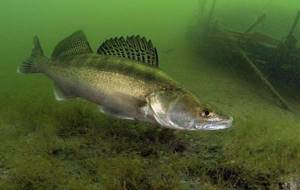
Canadian pike perch are smaller in size. The length of an adult individual reaches no more than 40 cm, and the average body weight is only 4 kg. The fish has a normal appearance - a spindle-shaped body. There are two dorsal, pelvic and pectoral fins, as well as a caudal fin with a classic notch. All fins are decorated with oblique lines of large black dots. The fish lives in North America. Canadian pike perch prefers large and small rivers; it is found a little less often in lakes and reservoirs. Compared to other species, the inhabitant of North America is considered a real long-liver. Its average life expectancy is about 18 years.
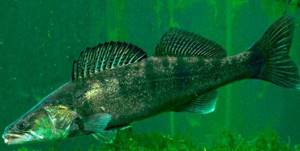
The Volga pike perch, like the Canadian pike perch, cannot boast of large sizes. It grows to a length of 45 cm, and the average weight of the fish usually does not exceed 3 kg. A characteristic feature of this species is the absence of fang-shaped teeth. Thanks to this feature, the Volga predator looks less dangerous. The fish lives in the Azov, Black and Caspian Seas.
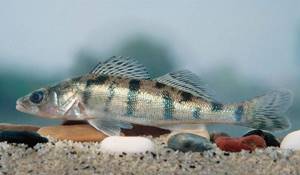
Sea pike perch lives in the Caspian and Black Seas. This is the only species that exchanged fresh water for salt water.
Outwardly, it is quite easy to distinguish it from other representatives of the Sudak family:
- The length is usually no more than 50 cm. Moreover, the body is flattened from the sides and quite narrow.
- The average weight reaches only 2 kg.
- The mouth is well defined, but it is significantly smaller than that of an ordinary pike perch.
- In Black Sea individuals there is no gap between the dorsal fins; they touch each other.
- There are no scales on the cheeks.
- The body of the fish is light gray with transverse dark stripes.
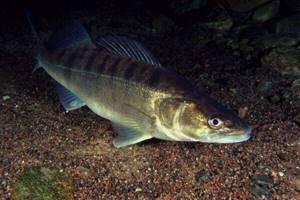
Lightfin pike perch is another large representative of the genus. The maximum length of a caught representative of this species was 107 cm, and its weight was 11 kg. More often there are individuals that are not so large in size. The color of pike perch depends on its habitat. The body is mostly olive brown or golden. The abdomen is lighter - yellowish or whitish.
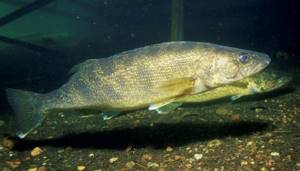
Among the people, pike perch has received a huge number of names, depending on its habitat:
- Ladoga pike perch.
- Ilmen pike perch.
- Chelmuzhsky pike perch.
- Syrdarya pike perch.
- Ural pike perch.
- Amudarya pike perch.
- Kuban pike perch.
- Don pike perch.
In fact, each of the names presented refers to one of the five species listed above. Another common name is river pike perch. This is the common name for all four types of freshwater fish, except sea fish.
Features of catching pike perch in winter
The period before freeze-up and first ice is the most fertile time for catching pike perch: although it moves to significant depths, it does not lose activity. Some break in its active biting is observed in the dead of winter - the fanged one becomes sluggish and cautious, takes the bait reluctantly and only if there is delicate equipment. And by spring, the predator becomes active again and is caught using all the typical gear for this period. The main thing during this period is to determine its location, which is very difficult without knowledge of the bottom topography.
The main active tackle for this period is a nodding fishing rod with a fairly powerful blank . Artificial baits are usually used as bait: small vertical spoons, balancers, rattlins, special winter “silicones”. In most cases, expressive play with the bait is practiced vertically, covering a range from 10 to 50 cm from the bottom, with pauses of 10-15 seconds. However, an experienced fisherman can quickly fish all horizons, select the optimal animation and provoke the fanged one to attack. Sometimes you can tap the bait on the bottom: a rising cloud of turbidity traditionally attracts a predator.
When using a jig, it is rational to paint it with fluorescent paint and supplement it with bloodworms or a piece of meat or fish, if the design allows it. Fishing with a nod or float rod using live bait also performs well , but the problem is that it is difficult to get live fry in winter. Therefore, many fishermen successfully catch pike perch in winter using sprat, which can be purchased at any grocery store. This bait has a characteristic tasty smell, but an attractive game is ensured by manipulations with the main artificial bait (spinner, jig, jig head), to which a dead fish is attached.
As an alternative, we can recommend the use of girders with live bait as bait . If there is a current, it is also possible to use a jig head or spoon in conjunction with the above-mentioned sprat. The main difficulty in this case is finding pike perch sites and drilling many holes, therefore the use of an echo sounder is strongly recommended.
Angling tips
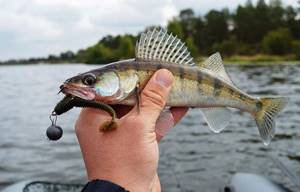
The fanged one is a difficult predator to catch, and you need to know a lot when hunting it. Therefore, as an additional bonus for beginners, here are some tips from experienced fishermen:
- Don't waste time on useless casts. It’s better to use the reserve in the right way: carefully examine the bottom of the reservoir in search of promising places. Pike perch is easier to catch than to find, so invest in an echo sounder. Can't afford it? Explore the bottom using a weight, the old-fashioned way.
- Don't use large baits. Pike perch immediately, on the spot, swallows prey in one sitting, so it prefers not too large fish with a narrow body. The bait should also have this shape. When selecting live bait, focus on 7-10 cm fish. The larger one can be used as a passive bait, cut into pieces.
- Do not install steel or Kevlar leashes on gear. You should not install equipment designed for pike fishing on pike perch. This is not necessary - the structure of the jaws will not allow the pike perch to bite through even high-quality monofilament, and a noticeable leash can alert it. It is better to give preference to fluorocarbon, which is hardly noticeable in the water - it will lull the vigilance of a predator with a sufficient margin of safety. However, it is not written on the tackle who exactly it is intended for, so a pike tempted by live bait can leave with part of the tackle. There are no universal recipes, it's up to you.
- Sharpen your hooks carefully. The palate of the fanged fish is very hard; you simply cannot penetrate it with a blunt sting, so it is recommended to choose hooks of the highest quality, chemically sharpened. Before fishing, check the sharpness of the tip on your nail and, if necessary, bring it to perfection.
- React instantly to bites. The pike perch grabs the prey immediately, but with some resistance from the rig it can release it from its mouth. Some experienced fishermen drop a couple of meters of fishing line so that the predator can more securely grab the bait, and only then hook it. Beginners are not recommended to take risks: hook the fanged one immediately after the bite, with a sharp movement, taking into account the hard lips of the predator.
We can talk endlessly about pike perch: fishermen are inventing new tricks to catch this predator. But the above information is enough for a novice fisherman to be able to navigate the methods and tactics of hunting the fanged robber!
Fishermen wonder why I’m biting and they’re not?
I’m revealing a secret just for you: it’s all about the miracle bait! More details
